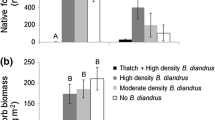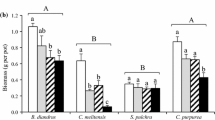Abstract
Exotic annual grasses have been introduced into many semi-arid ecosystems worldwide, often to the detriment of native plant communities. The accumulation of litter from these grasses (i.e. residual dry biomass) has been demonstrated to negatively impact native plant communities and promote positive feedbacks to exotic grass persistence. More targeted experiments are needed, however, to determine the relative impact of exotic grass litter on plant community structure across local environmental gradients. We experimentally added exotic grass litter to annual forb-dominated open woodland communities positioned along natural canopy cover gradients in southwest Western Australia. These communities are an important component of this region’s plant biodiversity hotspot and are documented to be under threat from exotic annual grasses. After a one-year treatment period, we measured the effects of exotic grass litter, soil properties, and canopy cover on native and exotic species richness and abundance, as well as common species’ biomass and abundances. Plant community structure was more strongly influenced by soil properties and canopy cover than by grass litter. Total plant abundances per plot, however, were significantly lower in litter addition plots than control plots, a trend driven by native species. Exotic grass litter was also associated with lower abundances of one very common native species: Waitzia acuminata. Our results suggest that exotic grass litter limits the establishment of some native species in this system. Over multiple years, these subtle impacts may contribute substantially to the successful advancement of exotic species into this system, particularly in certain microenvironments.




Similar content being viewed by others
References
Anand RR, Paine M (2002) Regolith geology of the Yilgarn Craton, Western Australia: implications for exploration. Aust J Earth Sci 49:3–162
Austin AT et al (2004) Water pulses and biogeochemical cycles in arid and semiarid ecosystems. Oecologia 141:221–235
Baskin CC, Chesson PL, Baskin JM (1993) Annual seed dormancy cycles in two desert winter annuals. J Ecol 81:551–556
Bates D, Maechler M, Bolker B, Walker S (2014) lme4: linear mixed-effects models using Eigen and S4. R package version 1.1-7
Bell DT, King LA, Plummer JA (1999) Ecophysiological effects of light quality and nitrate on seed germination in species from Western Australia. Aust J Ecol 24:2–10
Belsky AJ (1994) Influences of trees on savanna productivity: tests of shade, nutrients, and tree-grass competition. Ecology 75:922–932
Brown JH, Reichman OJ, Davidson DW (1979) Granivory in desert ecosystems. Annu Rev Ecol Syst 10:201–227
Carson W, Peterson C (1990) The role of litter in an old-field community: impact of litter quantity in different seasons on plant species richness and abundance. Oecologia 85:8–13
Coleman HM, Levine JM (2007) Mechanisms underlying the impacts of exotic annual grasses in a coastal California meadow. Biol Invasions 9:65–71
D’Antonio CM, Chambers JC (2006) Using ecological theory to manage or restore ecosystems affected by invasive plant species. In: Falk DA, Palmer MA, Zedler JB (eds) Foundations of restoration ecology. Island Press, Washington, pp 260–279
D’Antonio CM, Vitousek PM (1992) Biological invasions by exotic grasses, the grass/fire cycle, and global change. Annu Rev Ecol Syst 23:63–87
Diggle P, Heagerty P, Liang K-Y, Zeger S (2002) Analysis of longitudinal data. Oxford University Press, Oxford
Dwyer JM, Hobbs RJ, Mayfield MM (2014) Specific leaf area responses to environmental gradients through space and time. Ecology 95:399–410
Dwyer JM, Hobbs RJ, Wainwright CE, Mayfield MM (2015) Climate moderates release from nutrient limitation in natural annual plant communities. Global Ecol Biogeogr 24:549–561
Dyer AR, Rice KJ (1999) Effects of competition on resource availability and growth of a California bunchgrass. Ecology 80:2697–2710
Elston D, Moss R, Boulinier T, Arrowsmith C, Lambin X (2001) Analysis of aggregation, a worked example: numbers of ticks on red grouse chicks. Parasitology 122:563–569
Evans RA, Young JA (1970) Plant litter and establishment of alien annual weed species in rangeland communities. Weed Sci 18:697–703
Facelli JM (1994) Multiple indirect effects of plant litter affect the establishment of woody seedlings in old fields. Ecology 75:1727–1735
Facelli JM, Brock DJ (2000) Patch dynamics in arid lands: localized effects of Acacia papyrocarpa on soils and vegetation of open woodlands of South Australia. Ecography 23:479–491
Facelli JM, Carson WP (1991) Heterogeneity of plant litter accumulation in successional communities. B Torrey Bot Club 118:62–66
Facelli JM, Pickett ST (1991) Plant litter: its dynamics and effects on plant community structure. Bot Rev 57:1–32
Facelli JM, Williams R, Fricker S, Ladd B (1999) Establishment and growth of seedlings of Eucalyptus obliqua: interactive effects of litter, water, and pathogens. Aust J Ecol 24:484–494
Fowler N (1986) Microsite requirements for germination and establishment of three grass species. Am Midl Nat 115:131–145
Goldberg DE, Werner PA (1983) The effects of size of opening in vegetation and litter cover on seedling establishment of goldenrods (Solidago spp.). Oecologia 60:149–155
Grman E, Suding KN (2010) Within-year soil legacies contribute to strong priority effects of exotics on native California grassland communities. Restor Ecol 18:664–670
HilleRisLambers J, Yelenik SG, Colman BP, Levine JM (2010) California annual grass invaders: the drivers or passengers of change? J Ecol 98:1147–1156
Hobbs RJ, Huenneke LF (1992) Disturbance, diversity, and invasion: implications for conservation. Conserv Biol 6:324–337
Hobbs RJ, Norton DA (1996) Towards a conceptual framework for restoration ecology. Restor Ecol 4:93–110
Hopper SD, Gioia P (2004) The southwest Australian floristic region: evolution and conservation of a global hot spot of biodiversity. Annu Rev Ecol Evol S 35:623–650
Jasrotia P, McSwiney C (2008) Ion exchange resin strips to estimate nitrogen availability. Michigan State University, Kellogg Biological Station LTER. http://lter.kbs.msu.edu/protocols/105
Lai HR, Mayfield MM, Gay-des-combes JM, Spiegelberger T, Dwyer JM (2015) Distinct invasion strategies operating within a natural annual plant system. Ecol Lett 18:336–346
Lambers H, Raven JA, Shaver GR, Smith SE (2008) Plant nutrient-acquisition strategies change with soil age. Trends Ecol Evol 23:95–103
Lamont B (1985) Gradient and zonal analysis of understorey suppression by Eucalyptus wandoo. Vegetatio 63:49–66
Lenz TI, Facelli JM (2005) The role of seed limitation and resource availability in the recruitment of native perennial grasses and exotics in a South Australian grassland. Austral Ecol 30:684–694
Lenz TI, Moyle-Croft JL, Facelli JM (2003) Direct and indirect effects of exotic annual grasses on species composition of a South Australian grassland. Austral Ecol 28:23–32
Levine JM, McEachern AK, Cowan C (2008) Rainfall effects on rare annual plants. J Ecol 96:795–806
MacDougall AS, Turkington R (2005) Are invasive species the drivers or passengers of change in degraded ecosystems? Ecology 86:42–55
May F, Ash J (1990) An assessment of the allelopathic potential of Eucalyptus. Aust J Bot 38:245–254
Myers N, Mittermeier R, Mittermeier C, Da Fonseca G, Kent J (2000) Biodiversity hotspots for conservation priorities. Nature 403(6772):853–858
Palmer MA, Ambrose RF, Poff NL (1997) Ecological theory and community restoration ecology. Restor Ecol 5:291–300
Pérez-Fernández MA, Lamont BB, Marwick AL, Lamont WG (2000) Germination of seven exotic weeds and seven native speciesin south-western Australia under steady and fluctuating water supply. Acta Oecol 21:323–336
Pinheiro J, Bates D, DebRoy S, Sarkar D, R Developlment Core Team (2014) nlme: linear and nonlinear mixed effects models. R package version 3.1-128. http://CRAN.R-project.org/package=nlme
Prober SM, Smith FP (2009) Enhancing biodiversity persistence in intensively used agricultural landscapes: a synthesis of 30 years of research in the Western Australian wheatbelt. Agr Ecosyst Environ 132:173–191
Prober SM, Wiehl G (2011) Resource heterogeneity and persistence of exotic annuals in long-ungrazed Mediterranean-climate woodlands. Biol Invasions 13:2009–2022
Prober SM, Lunt ID, Thiele KR (2002a) Determining reference conditions for management and restoration of temperate grassy woodlands: relationships among trees, topsoils and understorey flora in little-grazed remnants. Aust J Bot 50:687–697
Prober SM, Thiele KR, Lunt ID (2002b) Identifying ecological barriers to restoration in temperate grassy woodlands: soil changes associated with different degradation states. Aust J Bot 50:699–712
Prober SM, Thiele KR, Lunt ID, Koen T (2005) Restoring ecological function in temperate grassy woodlands: manipulating soil nutrients, exotic annuals and native perennial grasses through carbon supplements and spring burns. J Appl Ecol 42:1073–1085
Prober SM, Standish RJ, Wiehl G (2011) After the fence: vegetation and topsoil condition in grazed, fenced and benchmark eucalypt woodlands of fragmented agricultural landscapes. Aust J Bot 59:369–381
R Development Core Team (2014) R: a language and environment for statistical computing. R Foundation for Statistical Computing, Vienna, Austria. http://www.R-project.org/
Scholes RJ, Archer SR (1997) Tree-grass interactions in savannas. Annu Rev Ecol Syst 28:517–544
Seabloom EW, Harpole WS, Reichman O, Tilman D (2003) Invasion, competitive dominance, and resource use by exotic and native California grassland species. Proc Natl Acad Sci USA 100:13384–13389
Standish RJ, Cramer VA, Hobbs RJ (2008) Land-use legacy and the persistence of invasive Avena barbata on abandoned farmland. J Appl Ecol 45:1576–1583
Vogt J (2013) Nitrate assay protocol. Schmidt Lab Group, SAFS, The University of Queensland, St Lucia, Australia
Wainwright CE, Cleland EE (2013) Exotic species display greater germination plasticity and higher germination rates than native species across multiple cues. Biol Invasions 15:2253–2264
Weltzin JF, Coughenour MB (1990) Savanna tree influence on understory vegetation and soil nutrients in northwestern Kenya. J Veg Sci 1:325–334
Wood S (2012) gamm4: generalized additive mixed models using mgcv and lme4, Version 0.2-4. https://CRAN.R-project.org/package=gamm4
Acknowledgements
We would like to acknowledge Richard J. Hobbs and members of the Mayfield Lab for comments on earlier versions of this manuscript, the Ecosystem Restoration and Intervention Ecology group at The University of Western Australia for logistical support, and Xingwen Loy for help with data collection in the field. This work was funded by a grant from the Australian Research Council (DP1094413) awarded to Margaret M. Mayfield and Richard J. Hobbs.
Author information
Authors and Affiliations
Corresponding author
Electronic supplementary material
Below is the link to the electronic supplementary material.
Rights and permissions
About this article
Cite this article
Wainwright, C.E., Dwyer, J.M. & Mayfield, M.M. Effects of exotic annual grass litter and local environmental gradients on annual plant community structure. Biol Invasions 19, 479–491 (2017). https://doi.org/10.1007/s10530-016-1303-2
Received:
Accepted:
Published:
Issue Date:
DOI: https://doi.org/10.1007/s10530-016-1303-2




